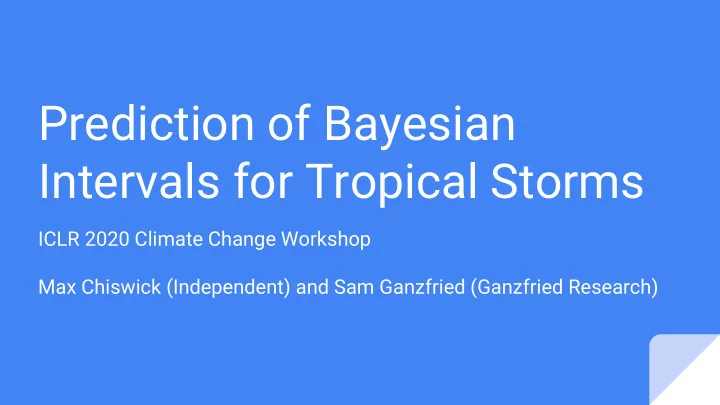

Prediction of Bayesian Intervals for Tropical Storms ICLR 2020 Climate Change Workshop Max Chiswick (Independent) and Sam Ganzfried (Ganzfried Research)
Tropical Storm Prediction with RNN ● Dataset: Tropical storms in the Atlantic Ocean ○ ○ 500 storms from 1982-2017 6 hour timesteps ○ ○ Prediction features: latitude, longitude, maximum surface wind (kt), minimum sea level pressure (hPa) Alemany (2019) used an RNN to show ● forecast error (blue line) superior to the National Hurricane Center (NHC) and Government Performance and Results Act (GPRA) targets for recent years
Uncertainty Cones National Hurricane Center (NHC) ● builds uncertainty cone such that ⅔ of historical forecast errors over the previous 5 years fall within the circle Our uncertainty interval instead ● uses fundamental Bayesian techniques and can use a variety of interval ranges up to 99%
Adding Uncertainty with Bayesian RNN ● Use dropout in both training and testing passes to model uncertainty (Gal, Ghahramani 2016) Every forward pass in the testing/prediction phase results in a different ● output Sample from a Bayesian approximation probabilistic distribution ○ Evaluate the distribution of many predictions to give a Bayesian interval ○
Adding Uncertainty with Bayesian RNN Posterior of weights is intractable Assume Gaussian prior p(w) = N (0, 1) Predictive distribution for new input point x* Approximate predictive distribution Use q(w) as approximating variational distribution and minimize KL( q ( w )| p ( w|X,Y )) Approximation at prediction time
Experiments Implemented RNN model with dropout on predictions ● ● Experiments with 100 and 400 predictions at different levels of dropout Created intervals based on mean, standard deviation, and Z-score for each timestep. We used Z- ● scores to represent intervals of 67%, 90%, 95%, 98%, and 99%. ● Using a dropout of 0.2, we show the true percentage of points within each of the interval bands over every timestep of that sample
Hurricane Katrina
Recommend
More recommend